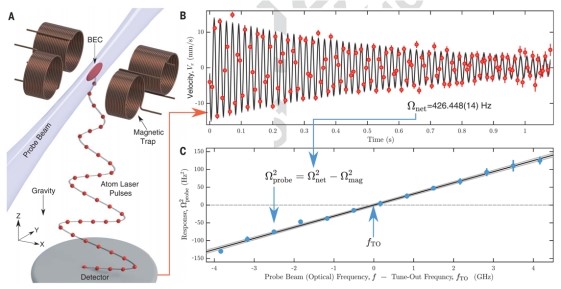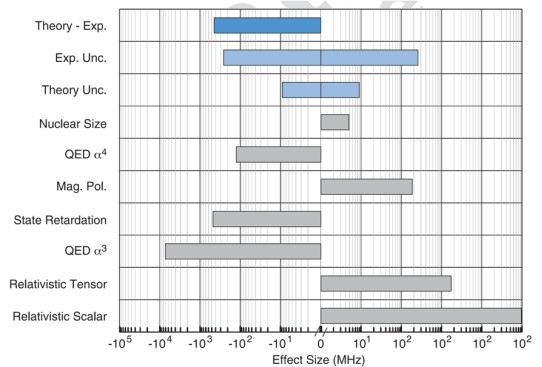In cooperation with the Australian National University (ANU) and the University of Windsor in Canada, the atomic and molecular external field theory group of Innovation Academy for Precision Measurement Science and Technology (APM), has determined the 413 nm tune-out wavelength of helium with high precision both in theory and experiment, which opens up a new way to test QED theory by measuring precisely the tune-out wavelength of "invisible" helium atom.
Quantum electrodynamics (QED) is a fundamental physical theory to describe the electromagnetic interaction between matter and light. It is the cornerstone of the development of modern physics. Testing QED theory helps to search for new physics beyond the standard model. Therefore, physicists have never stopped to test QED theory since it was put forward in the late 1940s. For example, precision measurements of the electron magnetic-moment anomaly and the atomic spectroscopy of hydrogen and helium.
Different from the traditional spectrum measurement method to test the QED theory, this work employed the tune-out wavelength of "invisible" atom to test it. The tune-out wavelength was defined as when the laser wavelength is modulated to a specific frequency, the Stark shift of a single energy level is zero, and the atom is like invisible in the laser field. The international cooperation team adopted a new method to measure the optical dipole potential by changing the spatial oscillation frequency of the Bose-Einstein-Condensation (BEC) of helium atoms in the magnetic trap. At the same time, combined with high-accuracy atomic structure calculation, they realized a new test of QED theory at the level of one part in ten million. The work has been published recently in Science. K. Baldwin group of ANU is responsible for experimental measurement, Prof. Li-Yan Tang and Associate Prof. Yong-Hui Zhang of APM and Prof. G.W.F. Drake of Windsor University are responsible for theoretical calculations.
The new scheme of testing atomic QED theory by using the tune-out wavelength was put forward firstly by Prof. J. Mitroy of Charles Darwin University and Dr. Li-Yan Tang of APM (formerly Wuhan Institute of Physics and Mathematics) in 2013 [Phys. Rev. A 88, 052515 (2013)]. In 2015, the experimental group of Prof. K. Baldwin at ANU measured the tune-out wavelength of helium with a precision of 5 ppm (~ 10-6) [Phys. Rev. Lett. 115, 043004 (2015)]. There was a 134 ppm discrepancy between the measurement and the theoretical prediction at that time. In order to resolve this discrepancy, the theoretical team of APM independently developed a series of high-accuracy calculation methods and determined the tune-out wavelength with an accuracy of 0.1 ppm [Phys. Rev. A 99, 040502 (R) (2019)], which have promoted a new round of international cooperation.
The deepen cooperation between theory and measurement has been continued since 2019. The experimental team have developed the most sensitive method ever for measuring the potential energy of an atom (within a hundredth of a decillionth of a joule – or 10-35 joule, see Fig. 1), and used it to realize the measurement of the tune-out wavelength for the “invisible” helium atom with an precision of 0.35 ppm, which is a 20-fold improvement in the precision over the sole previous measurement in 2015. The theoretical team formed by APM and the University of Windsor, Canada improved the state-of-the-art calculation of the tune-out wavelength by accounting for the finite wavelength retardation effect and the magnetic susceptibility accurately, and determined the tune-out frequency with an accuracy of one part in a hundred million (10 ppb ~ 10-9). The comparisons between theory and experiment have verified the sensitivity of the tune-out wavelength to the QED and retardation effects (see Fig.2), which also provides a corroboration of the theoretical prediction put forward firstly by Jim Mitroy and Li-Yan Tang. In the future, the measured precision of the tune-out wavelength is expected to be improved to a level of 30 ppb and will be used to probe atomic nuclear information, which would open a new research window for exploring atomic nuclear properties from the perspective of "invisible" atoms.

Fig. 1. Experimental procedure: Method to determine the tune-out for a fixed probe beam polarization. (A) A magnetically trapped BEC of metastable helium atoms was illuminated with a probe laser beam with an adjustable (optical) frequency. A sequence of atom laser pulses was outcoupled from the BEC to sample the oscillation. (B) The mean velocity of each pulse in the x direction (vx) was used to trace out the oscillation over time (red points) and extract the oscillation frequency with a dampened sine wave fit (solid line). A single experimental realization is shown. (C) The squared probe beam trap frequency (response) was found using a separate measurement of the magnetic trap
frequency. This measurement was repeated over a small range of optical frequencies. The tune-out was extracted by finding the x intercept of the response as a function of probe beam frequency using a linear fit (solid black line). Light-gray lines show the model 1s confidence intervals. All error bars represent the standard error in the mean.

Fig. 2. Experimental and theoretical sensitivity. Comparison of uncertainties in the theoretical and experimental determinations of the 23S1–23P/33P tune-out frequency and the various theoretical contributions to the tune-out value. Exp. Unc., experimental uncertainty; Theory Unc., theoretical uncertainty; Mag. Pol., magnetic polarizability.
This work was supported by the National Key Research and Development Program of China, the Strategic Priority Research Program of the Chinese Academy of Sciences, and the National Natural Science Foundation.
Full text link:https://www.science.org/doi/10.1126/science.abk2502
